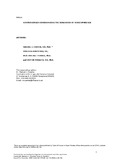Mostrar el registro sencillo del ítem
Controversies surrounding the diagnosis of schizophrenia and other psychoses
| dc.creator | Cuesta, Manuel J. | es_ES |
| dc.creator | Basterra, Virginia | es_ES |
| dc.creator | Sánchez Torres, Ana María | es_ES |
| dc.creator | Peralta Martín, Víctor | es_ES |
| dc.date.accessioned | 2024-01-29T16:48:42Z | |
| dc.date.available | 2024-01-29T16:48:42Z | |
| dc.date.issued | 2009 | |
| dc.identifier.citation | Cuesta, M. J., Basterra, V., Sanchez-Torres, A., Peralta, V. (2009) Controversies surrounding the diagnosis of schizophrenia and other psychoses. Expert Review of Neurotherapeutics, 9(10), 1475-1486. https://doi.org/10.1586/ern.09.102. | en |
| dc.identifier.issn | 1473-7175 | |
| dc.identifier.uri | https://hdl.handle.net/2454/47237 | |
| dc.description.abstract | The diagnosis of schizophrenia and other psychotic disorders in current psychiatric classifications identifies individuals who are severely ill but who have few clinical characteristics in common. The usual picture of psychotic patients is a mixture of mood and psychotic symptoms. Fortunately, clinicians do not base their therapeutic strategies exclusively on diagnosis, but also on symptom predominance. Thus, clinicians’ treatments have been dimensional in nature for years, although, until recently, their psychiatric classifications had been mainly categorical. The main principle in psychosis classification has been the Kraepelinian dichotomy, despite its lack of enduring empirical validation. Without doubt, current psychiatric classifications have made great strides in reliability and clinical utility, although these advantages have not been enough to compensate for their shortcomings concerning validity. It has recently been suggested that the Kraepelinian dichotomy may be hindering progress in neurobiological research within psychosis. Mounting evidence is now fuelling a paradigm shift in the ongoing process of review of psychiatric classifications toward the introduction of complementary dimensional indicators of psychiatric categorical diagnoses. This new approach will allow us to understand psychosis as prototypical extremes of a severity continuum. The gradients of this continuum may begin with subtle expressions in the general population, continue with milder forms in relatives of psychotic patients and subclinical cases and finally reach the prototypical forms of psychosis at the other extreme. Future complementary dimensional indicators will require sound instruments capable of reflecting a multidimensional assessment of psychopathological symptoms, polydiagnostic interviews and the assessment of a wide range of nonsymptomatic domains. These new methods of assessment merging created by the shift toward a dimensional paradigm will be applied in the forthcoming new diagnostic criteria and may allow for a phenome-wide scanning for psychosis. | en |
| dc.description.sponsorship | Supported in part by grants 55/2007 from the Department of Health of the Navarre Regional Government, PI81026 from FIS (Fondo de Investigaciones Sanitarias) of the Spanish Ministry of Health, and 2008/030 from The National Drug Plan of Spain. | en |
| dc.format.mimetype | application/pdf | en |
| dc.language.iso | eng | en |
| dc.publisher | Taylor and Francis | en |
| dc.relation.ispartof | Expert Review of Neurotherapeutics 2009, 9(10), 1475-1486 | en |
| dc.subject | Diagnostic issues | en |
| dc.subject | Phenome-wide scanning | en |
| dc.subject | Psychopathology | en |
| dc.subject | Psychosis | en |
| dc.subject | Schizophrenia | en |
| dc.title | Controversies surrounding the diagnosis of schizophrenia and other psychoses | en |
| dc.type | Artículo / Artikulua | es |
| dc.type | info:eu-repo/semantics/article | en |
| dc.date.updated | 2024-01-29T16:29:24Z | |
| dc.contributor.department | Ciencias de la Salud | es_ES |
| dc.contributor.department | Osasun Zientziak | eu |
| dc.rights.accessRights | Acceso abierto / Sarbide irekia | es |
| dc.rights.accessRights | info:eu-repo/semantics/openAccess | en |
| dc.identifier.doi | 10.1586/ern.09.102 | |
| dc.relation.publisherversion | https://doi.org/10.1586/ern.09.102 | |
| dc.type.version | Versión aceptada / Onetsi den bertsioa | es |
| dc.type.version | info:eu-repo/semantics/acceptedVersion | en |


